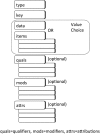Clinical element models in the SHARPn consortium
- PMID: 26568604
- PMCID: PMC6283078
- DOI: 10.1093/jamia/ocv134
Clinical element models in the SHARPn consortium
Abstract
Objective: The objective of the Strategic Health IT Advanced Research Project area four (SHARPn) was to develop open-source tools that could be used for the normalization of electronic health record (EHR) data for secondary use--specifically, for high throughput phenotyping. We describe the role of Intermountain Healthcare's Clinical Element Models ([CEMs] Intermountain Healthcare Health Services, Inc, Salt Lake City, Utah) as normalization "targets" within the project.
Materials and methods: Intermountain's CEMs were either repurposed or created for the SHARPn project. A CEM describes "valid" structure and semantics for a particular kind of clinical data. CEMs are expressed in a computable syntax that can be compiled into implementation artifacts. The modeling team and SHARPn colleagues agilely gathered requirements and developed and refined models.
Results: Twenty-eight "statement" models (analogous to "classes") and numerous "component" CEMs and their associated terminology were repurposed or developed to satisfy SHARPn high throughput phenotyping requirements. Model (structural) mappings and terminology (semantic) mappings were also created. Source data instances were normalized to CEM-conformant data and stored in CEM instance databases. A model browser and request site were built to facilitate the development.
Discussion: The modeling efforts demonstrated the need to address context differences and granularity choices and highlighted the inevitability of iso-semantic models. The need for content expertise and "intelligent" content tooling was also underscored. We discuss scalability and sustainability expectations for a CEM-based approach and describe the place of CEMs relative to other current efforts.
Conclusions: The SHARPn effort demonstrated the normalization and secondary use of EHR data. CEMs proved capable of capturing data originating from a variety of sources within the normalization pipeline and serving as suitable normalization targets.
Keywords: controlled; electronic health records/standards; health information systems/standards; information storage and retrieval; semantics; vocabulary.
© The Author 2015. Published by Oxford University Press on behalf of the American Medical Informatics Association. All rights reserved. For Permissions, please email: journals.permissions@oup.com.
Figures






References
-
- Coyle JF, Rossi Mori A, Huff SM . Standards for detailed clinical models as the basis for medical data exchange and decision support . Int J Med Inf 2003. ; 69 ( 2–3 ): 157 – 174 . - PubMed
-
- Coyle JF . The Clinical Element Model Detailed Clinical Models [dissertation] . Salt Lake City: : The University of Utah; ; 2013. .
-
- Huff SM, Rocha RA, Coyle JF, et al. . Integrating detailed clinical models into application development tools . Stud Health Technol Inform 2004. ; 107 ( Pt 2 ): 1058 – 1062 . - PubMed
-
- Parker CG, Rocha RA, Campbell JR, et al. . Detailed clinical models for sharable, executable guidelines . Stud Health Technol Inform 2004. ; 107 ( Pt 1 ): 145 – 148 . - PubMed
Publication types
MeSH terms
Grants and funding
LinkOut - more resources
Full Text Sources
Other Literature Sources

